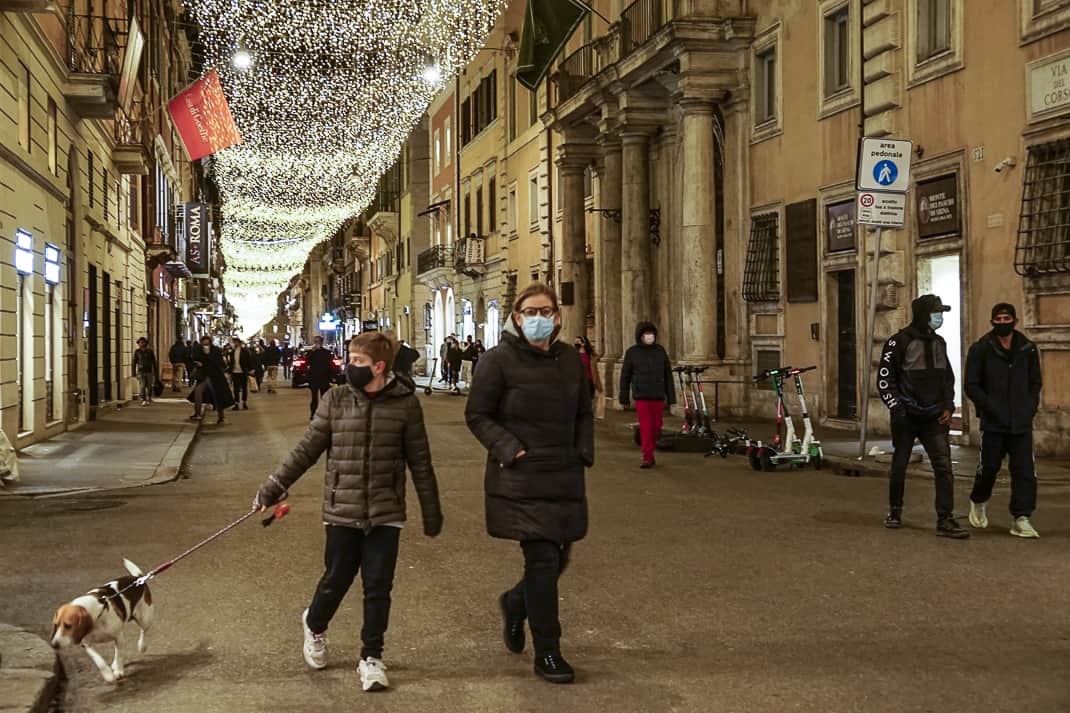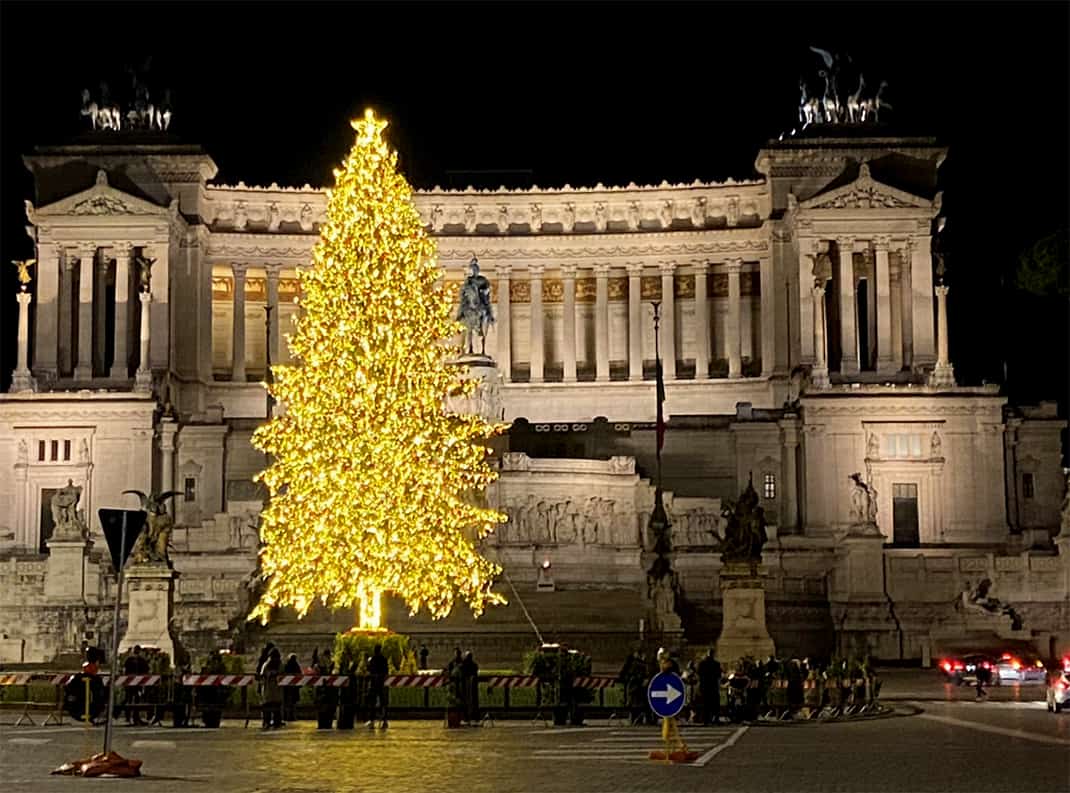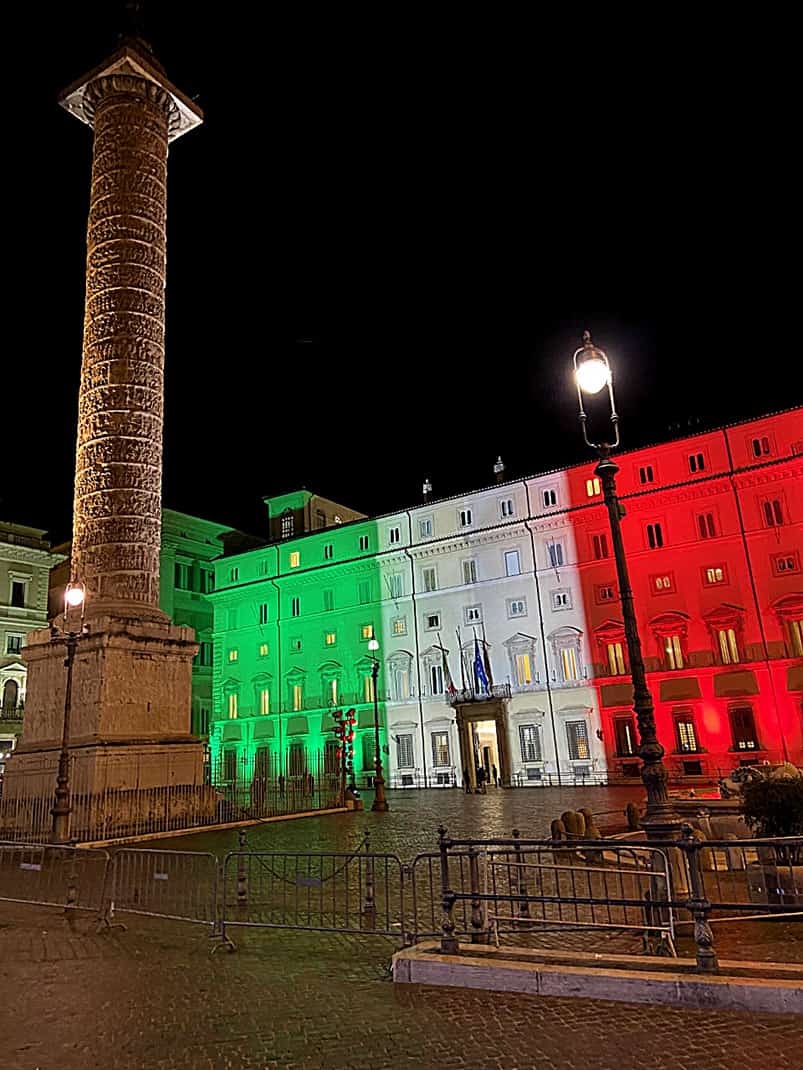Christmas in pandemic Rome: Quiet nights and strict rules as Covid-19 plays Grinch

The man selling roasted chestnuts on the corner near the Spanish Steps looked as bored as a stuffed reindeer. He glanced at his watch. He looked at me. I looked at his pile of smoking, browned chestnuts and smelled the glorious aroma that always makes Christmas in Rome so sweet.
But no one was buying. No one was around. It was me and one lone photographer shooting the majestic Spanish Steps at about the only time I recall seeing them completely empty. I saw one man scurry down with a briefcase, obviously not a tourist.
Here in Rome this year we’ve probably had the fewest tourists since the 5th century when the Sack of Rome turned the world’s most powerful civilization into Des Moines after a tornado. Now that it’s holiday season, the pandemic has Rome in its vice again.
Rome’s Christmas scene
I went into Rome’s shopping district Monday night at 7:30. In past years, ritzy Via del Corso would be closed off to traffic and Christmas shoppers would be cheek to jowl. Via Candotti, arguably the most exclusive shopping street in Rome, would be crawling with people preening through the stylish windows of Sergio Rossi, Prada and Gucci. The Spanish Steps? Well, combine holiday cheer with one of the most romantic sites in Italy and you have lovers chewing each other’s faces off in a dimly lit piazza.
But Christmas in pandemic Rome means nearly every Rome store closing at 6 p.m. and shopping centers and malls closed all weekend. What’s left for me at 7:30 on a Monday was a quiet stroll through Rome’s always understated Christmas decor. A long string of gold lights hung over Corso with “Rome by Light” and “Roma Capitale” lit up in white over one intersection. Green and red spotlights lit up the 16th century Chigi Palace, official residence of the prime minister, making it look like a giant Italian flag or a Christmas banner, depending on your spirit.

I saw a homeless man curl up next to his cardboard sign and cup in the doorway of the high-end men’s store, Doppelganger. What cruel irony to the economic devastation of a pandemic.
Lots of police and Carabinieri cruised the streets waiting to fine anyone without a mask 400-1,000 euros. Anyone caught out after the 10 p.m. curfew the fine is also 400 euros.
It’s not like Romans can’t or are unwilling to shop. On Sunday I took a bus into the Monti neighborhood by the Colosseum for lunch and the streets were jammed with traffic and pedestrians. To drive three miles it took my bus an hour. Police had to block off Trevi Fountain after crowds became too large.

But unlike some Western powers in North America south of Canada, Italy actually has national rules in place to fight Covid-19. Conte established them in October and on Dec. 3 extended them through the holidays. Such as:
- All restaurants and bars close at 6.
- Curfew from 10 p.m.-5 p.m.
- Gyms and cinemas closed.
- Museums and art galleries closed.
- All high schools taught remotely.
- Masks are mandatory everywhere outside except when eating, drinking or doing cardio activity such as cycling or jogging. Fines range from 400-1,000 euros.
New Covid restrictions map
In addition, the government divided Italy’s 20 regions into a three-tier system: red, orange and yellow. In red regions, residents must stay within their regions and can only move around their own area for essential reasons such as work, study or health.
Orange regions residents aren’t allowed to travel from one town to another except for essential reasons but are allowed to travel inside their area.
Residents in yellow regions have no further restrictions besides the national.

With much of the country in semi-lockdown, our second wave is starting to curve downward:
- The daily average of new cases per week has dropped from 24,251 Nov. 23-30 to 20,143 Nov. 30-Dec. 7 and 16,169 from Dec. 7-14. (Meanwhile, in the U.S. the same daily average has gone from 164,435 to 184,917 to 218,226 this past week, respectively.)
- Average daily deaths in Italy have dropped from 732 to 719 to 629 this past week. (In the U.S. it has gone from 1,522 to 1,872 to 2,527.)
- Active cases since Nov. 25 in Italy have dropped 116,586. (In the U.S. since Nov. 25 they have increased 1,660,369.)
- In Rome, our number of new daily cases have dropped over the past four weeks from 2,031 to 1,608 to 1,265 to 1,117 this past week.

In response to the downturn, on Nov. 29 Prime Minister Conte moved five regions — Calabria, Liguria, Lombardy, Piedmont and Sicily — from red to orange then on Friday moved Lombardy, Piedmont, Basilicata and Calabria to yellow. After also moving Abruzzo from red to orange, no region is currently red and under the strictest restrictions.
However, the government and health ministers remain cautious. After residents took advantage of store openings in Lombardy, photos of packed crowds in Milan went viral in Italy — and straight to the nervous system of the country’s health personnel.
“Don’t let us see any more photos like the ones from today,” said Domenico Arcuri, Italy’s Covid-19 emergency commissioner, Sunday night. “We must all avoid a third wave taking place.”
Conte has banned travel between regions from Dec. 21-Jan. 6 after widespread opposition against the ban on Dec. 25, 26 and Jan. 1. According to The Local, Italy’s lone English-language news source, Conte is considering a change in travel restrictions. However, we all saw what happened in August after Italians took advantage of the flattened curve and started traveling to infected regions.

In came the second wave.
“I would like to say that it’s all over but unfortunately it’s not,” health minister Roberto Speranza said in The Local. “We have asked Italians for more patience and sacrifices over this Christmas, too. We really need to stick to our guns.”
Added regional affairs minister Francesco Boccia: “The risk of a third wave is almost certain” if people aren’t careful.
Midnight mass moves up
Even the pope is doing his part. He’s moving his annual 90-minute midnight mass from 9:30 p.m. Christmas Eve to 7:30 so everyone can make curfew. He’ll limit the size of the audience which usually fills massive St. Peter’s Square. He has already cancelled a weekly audience due to a rise in Covid infections last month.
I will be cautious, too. Marina, my girlfriend, and I long ago shelved plans to spend Christmas in Rovaniemi, Finland, the mythical home of Santa Claus. We’ll have our annual massive Christmas Eve feast at her parents’ where seven of us will gather, barring restrictions change, meeting Conte’s request to use “common sense” in the size of our family gathering.
Christmas in Rome is like Christmas nowhere else. But Christmas this year anywhere is like no other. At least we’re alive and well in a country headed in the right direction. Those are the best Christmas gifts of all.


December 15, 2020 @ 8:55 am
Deaths per capita:
Italy 0.00108
United States: 0.00092
There’s much to question about the US, but let’s be fair about coronavirus. The US has survived slightly better than Italy.
January 28, 2021 @ 12:58 pm
facts are facts……